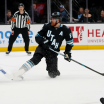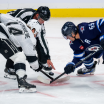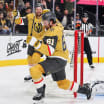The Capitals' commitment to defense was evident by their 26 blocked shots in Game 3, including 15 in the first period. Vegas attempted 62 shots on Saturday; 22 got to goalie Braden Holtby. The only goal Vegas scored was off a turnover by Holtby that had nothing to do with defensive zone coverage.
It was similar to how the Capitals played in Games 3-6 against the Columbus Blue Jackets in the Eastern Conference First Round, all wins, and throughout their second-round series against the Pittsburgh Penguins. It was almost identical to how they played in Game 6 and most of Game 7 against the Tampa Bay Lightning in the conference final, when they didn't allow a goal and won the series.
"The thing about defending is if you defend well, you have the puck more, you get it back sooner, and that's when we're at our best," Niskanen said. "I think guys bought into it and it's helped us. We got the gist of it then. He challenged us to be better without the puck because he knew it was going to help us overall. Guys have bought into that, and it's working."
The meeting about toughness was essentially Trotz testing his players' manhood and will. He used examples of Washington players being beaten to pucks and outmuscled by smaller players on rival teams, Niskanen said.
"There was a raised voice and a clear message," center Lars Eller said. "He didn't have to raise his voice a whole lot and have a whole lot of emotion, but just the fact that he did it to some level, that made the meeting different."
It was jarring to hear, but important nonetheless.
"I think it just gave me an opportunity to be honest with myself," Niskanen said. "I think that happened with a lot of guys. Maybe some guys it went right over their head, but for the guys who have been here the longest, those are the guys that said, 'He's right here, we've got to find another level.'"


















